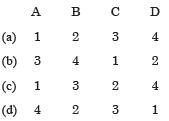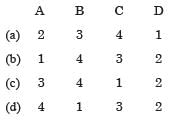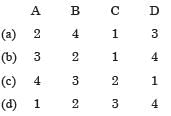Test: History & Culture - 5 - UPSC MCQ
30 Questions MCQ Test - Test: History & Culture - 5
Consider the following statements:
1. Rig Vedic tribal chiefs had unlimited powers.
2. Vrajapati was the officer responsible for collection of taxes in the Rig Vedic period.
3. Status of women in the early Vedic period was better than that in later Vedic period.
Which of the above statements is/are incorrect?
1. Rig Vedic tribal chiefs had unlimited powers.
2. Vrajapati was the officer responsible for collection of taxes in the Rig Vedic period.
3. Status of women in the early Vedic period was better than that in later Vedic period.
Which of the above statements is/are incorrect?
Consider the following statements:
1. Bhavai involves women balancing nine brass pitchers or earthen pots on their head as they dance, feet on the perimeter of a brass plate or on the top of a glass.
2. In Chari, women are attired in traditional outfit and dance while balancing brass chari on their heads, along with a lighted lamp in it.
3. Chang dance form is the fast-paced rhythmic beats of the chang instrument, upon which a group of men dance.
Which of the above statements is/are Correct?
1. Bhavai involves women balancing nine brass pitchers or earthen pots on their head as they dance, feet on the perimeter of a brass plate or on the top of a glass.
2. In Chari, women are attired in traditional outfit and dance while balancing brass chari on their heads, along with a lighted lamp in it.
3. Chang dance form is the fast-paced rhythmic beats of the chang instrument, upon which a group of men dance.
Which of the above statements is/are Correct?
The decline of the Mughal Empire led to a rise in the number of regional states. Consider the following statements in this regard:
1. Mysore and Kerala emerged as successor states.
2. The Successor States accepted the sovereignty of the Mughal ruler.
3. Awadh, Bengal, and Hyderabad were established during the reign of Mughal Emperor –Muhammad Shah.
Which of the above statements is/are correct?
1. Mysore and Kerala emerged as successor states.
2. The Successor States accepted the sovereignty of the Mughal ruler.
3. Awadh, Bengal, and Hyderabad were established during the reign of Mughal Emperor –Muhammad Shah.
Which of the above statements is/are correct?
Consider the following statements with respect to the socio-economic system during the Sultanate period:
1. Khalisa was the land under the direct control of the Sultan.
2. Zimmis were the Turkish nobles who were positioned at high places in the Sultanate rule.
Which of the above statements is/are correct?
Which of the following is not correct regarding the ‘Day of Deliverance’ observed by Muslim league?
Gandhi and B.R. Ambedkar shared many ideas, though in many ways they held different beliefs. In this context, consider the following statements:
1. Ambedkar advocated annihilation of caste system to remove untouchability while Gandhi did not oppose the caste system.
2. Gandhi approved a separation of politics and religion as opposed to Ambedkar.
3. Both Gandhi and Ambedkar were in favor of ‘Gramraj’ as it meant real independence for Indians.
Which of the above statements is/are correct?
With reference to the Rudradaman I, consider the following statements:
1. He was the most famous Kushan ruler who ruled over Sindh.
2. He undertook the repair works to improve the Sudarshana Lake in the semi-arid zone of Kathiawar.
3. He was a great lover of Sanskrit.
Which of the above statements is/are incorrect?
With reference to Lahore Resolution, consider the following statements:
1. It was adopted by the All-India Muslim League in March 1939.
2. It called for an independent state for Muslims of British India.
3. It was presented by Mohammad Ali Jinnah.
Which of the above statements is/are correct?
The British employed various diplomatic and administrative mechanisms along with direct conquest through wars for expanding their empire. In this context, consider the following statements:
1. Warren Hastings adopted the policy of ring-fence.
2. Lord Wellesley’s subsidiary alliance increased the political independence of Indian states.
3. Lord Dalhousie was the originator of the policy of Doctrine of Lapse.
Which of the above statements is/are correct?
Match the following literatures related to the Delhi Sultanate period with their Authors:

Select the correct answer using the code given below:

Consider the following statements regarding Champaran Satyagraha:
1. It was caused against tinkathia system of indigo growing.
2. It was the first battle of civil disobedience.
3. Mahatma Gandhiji and Jawaharlal Nehru were the popular leaders of this movement.
Which of the above statements are correct?
Which of the following is incorrect regarding Jinnah Direct Action Resolution?
The Gupta period is remarkable for the production of literary works. In this context consider the following statements:
1. Bhasa was the author of a drama called Dradiracharudatta.
2. Amarakosha was compiled by Amarasimha.
Which of the above statements is/are correct?
Which among the following is/are the features of Maratha administration during Shivaji’s rule?
1. The king was assisted by a council of ministers called the Ashtapradhan.
2. These offices of ministers were hereditary.
3. Shivaji built a powerful navy.
4. Sardeshmukhi was an additional levy of ten percent paid to the Marathas in order to avoid the Maratha raids.
Select the correct answer using the code given below:
With reference to early Nationalist critique of Colonial Economy, consider the following statements:
1. They were against the process of modernization.
2. Most of them belonged to the moderate group of the Indian National Congress.
3. They wanted British capital surplus to enter India as finance capital.
Which of the above statements is/are correct?
With reference to Dahsala or Zabti system of land revenue assessment, consider the following statements:
1. It was a system of ten year settlement but not a permanent one as the state retained the right of modification.
2. Peasants were given the choice of paying in cash or kind under this system.
Which of the above statements is/are correct?
With reference to the Poona Pact, 1932, consider the following statements:
1. It was signed by Mahatma Gandhi on behalf of depressed classes.
2. It provided separate electorates to depressed classes.
3. It did not fulfilled its aim of liberating depressed classes from social order.
Which of the above statements is/are correct?
Who among the following freedom fighters was called ‘Prince among the Patriots’ by Mahatma Gandhi?
Ashokan inscriptions, considered to be the earliest were written in which of the following scripts?
1. Aramaic
2. Greek
3. Kharoshthi
4. Brahmi
Select the correct answer using the code given below:
Consider the following statements regarding Later Vedic Age Economy:
1. It was mainly based on use of copper.
2. Agriculture could not be performed due to lack of plough.
3. Tax collection was done by Sangrihitri.
Which of the above statements is/are correct?
Which of the following statements regarding Tipu Sultan is/are correct?
1. He organized his army on the European model with Persian words of command.
2. He became a member of Jacobin Club and also planted a Tree of Liberty at Seringapatam.
Select the correct answer using the code given below:
Consider the following statements regarding Turkish king Balban:
1. The Persian festival of Nauroz was introduced by him.
2. He is known to have included non-Turks to his administration.
3. Balban followed the policy of ‘Tolerance and Recognition’ for building peace and control in the region.
Which of the above statements is/are incorrect?
Consider the following statements regarding the Indian revolutionaries abroad:
1. The Berlin Committee for Indian Independence was established in 1915 by Virendranath Chattopadhyay and Bhupendranath Dutta.
2. Shyam Krishna Verma founded an India Home Rule Society in London.
3. Dadabhai Naoroji brought out a monthly journal ‘Indian Sociologist’ in England.
Which of the above statements is/are correct?
Consider the following statements regarding Pakistan Resolution (1940):
1. It was held in Karachi.
2. It called for grouping of only Muslim majority North-West region into an independent state.
Which of the above statements is/are correct?
Match the following:

Select the correct answer using the code given below:

Consider the following statements with regard to the National Planning Committee:
1. It was set up by Jawaharlal Nehru.
2. M. Visvesvaraya was elected as the head of the Planning Committee.
Which of the above statement is/are incorrect?
Match the following British officials with the nerve centers which were recovered by them during the Revolt of 1857:

Select the correct answer using the code given below:

With reference to the cultural contributions of the Deccan States, consider the following statements:
1. Ali Adil Shah invited Christian missionaries to his court even before Akbar had done so.
2. Muhammad Quli Qutub Shah was a contemporary of Akbar who constructed Char Minar.
3. Gol Gumbaz built by rulers of Bijapur has the single largest dome ever constructed.
Which of the above statements is/are correct?
Who among the following launched the Muslim Mass Contact Programme in India?
Consider the following statements related to the kisan sabha movement:
1. The United Province Kisan Sabha was set up by Gauri Shankar Mishra and Indra Narayan Dwivedi.
2. Home Rule activists supported it.
Which of the above statements is/are correct?























